
Phalaenopsis, also known as moth orchids, is a genus of about seventy species of plants in the family Orchidaceae. Orchids in this genus are monopodial epiphytes or lithophytes with long, coarse roots, short, leafy stems and long-lasting, flat flowers arranged in a flowering stem that often branches near the end. Orchids in this genus are native to India, Taiwan, China, Southeast Asia, New Guinea and Australia with the majority in Indonesia and the Philippines.
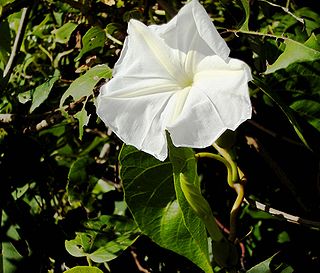
Ipomoea violacea is a perennial species of Ipomoea that occurs throughout the world with the exception of the European continent. It is most commonly called beach moonflower or sea moonflower as the flowers open at night.

The Anthophorini are a large tribe in the subfamily Apinae of the family Apidae. Species in this tribe are often referred to as digger bees, although this common name is sometimes also applied to members of the tribe Centridini. It contains over 750 species worldwide, all of which were previously classified in the obsolete family Anthophoridae along with members of several other tribes; the vast majority of species in the tribe Anthophorini are in the genera Amegilla and Anthophora.

Banksia violacea, commonly known as violet banksia, is a species of shrub or tree in the plant genus Banksia. It generally grows as a small shrub to 1.5 m (5 ft) high with fine narrow leaves, and is best known for its unusually coloured dark purple-violet inflorescences. The colour of the inflorescences, short leaves, and flattened follicles which are sticky when young, help identify this species from others in the field. It is found in low shrubland in southern regions of Western Australia from Esperance in the east to Narrogin in the west, growing exclusively in sandy soils.

Australia has over 1,700 species of native bee. Bees collect pollen from flowers to feed their young. Flies do not do this, although they may be seen eating pollen, so identification is not always easy.
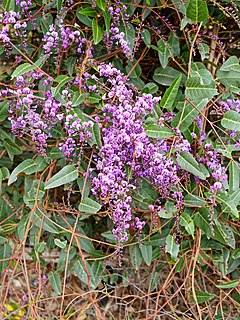
Hardenbergia violacea is a species of flowering plant in the family Fabaceae and is endemic to Australia. It is known in Australia by the common names false sarsaparilla, purple coral pea and waraburra. Elsewhere it is also called purple twining-pea, vine-lilac and wild sarsaparilla. It is a prostrate or climbing subshrub with egg-shaped to narrow lance-shaped leaves and racemes of mostly purple flowers.
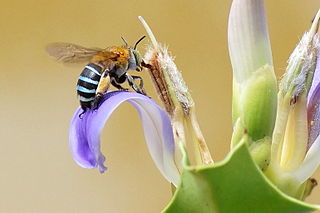
Amegilla is a large genus of bees in the tribe Anthophorini. Several species have blue metallic bands on the abdomen, and are referred to as "blue-banded bees". The genus occurs all around the world but very few live above 45° North.

Amegilla cingulata is a species of blue-banded bee native to Australia. Currently, several scientific organizations are conducting research on how A. cingulata benefits agriculture through its distinctive "buzz pollination".

Phalaenopsis pulcherrima is a species of orchid found from Hainan Island to western Malesia.

Amegilla bombiformis, commonly known as the teddy bear bee or golden haired mortar bee, is an Australian native bee in the family Apidae.
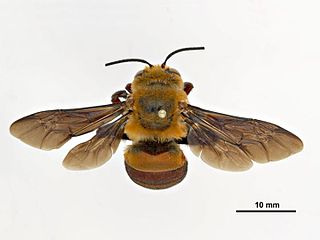
Amegilla dawsoni, sometimes called the Dawson's burrowing bee, is a species of bee that nests by the thousands in arid claypans in Western Australia. It is a long tongued bee, of the tribe Anthophorini and genus Amegilla, the second largest genus in Anthophorini.

Amegilla quadrifasciata, the white-banded digger bee, is a species of bee belonging to the family Apidae subfamily Apinae.
Amegilla fallax is a species of bee belonging to the family Apidae subfamily Apinae.
Amegilla subcoerulea is a species of bee belonging to the family Apidae subfamily Apinae.
Amegilla cingulifera, is a species of bee belonging to the family Apidae subfamily Apinae.
Amegilla niveocincta, is a species of bee belonging to the family Apidae subfamily Apinae.

Amegilla asserta is a species of bee endemic to Australia, belonging to the family Apidae subfamily Apinae. Females forage by performing buzz pollination.

Amegilla zonata is a species of blue-banded bees belonging to the family Apidae, widely distributed in Southeast Asia, where it is often confused with the Australian species Amegilla cingulata.
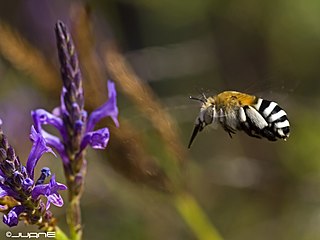
Amegilla canifrons, the Canary islands Blue-banded bee is a species of bee, belonging to the family Apidae. The species is endemic to Canary Islands.














